This is an extended version of my original article on Costa Rica.
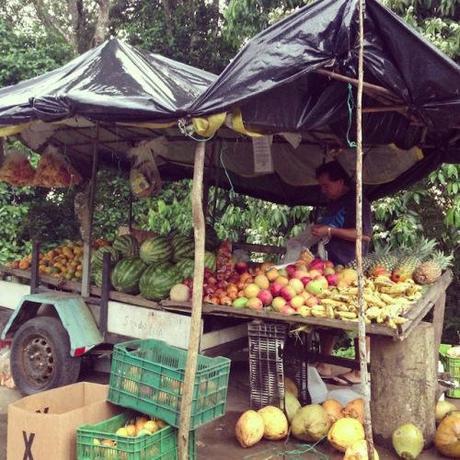
Fruit Stand by Courtney McCubbin
WASHINGTON DC, February 16, 2013- This January, my husband and I visited Costa Rica for a wedding. Growing up in a Latin culture, I associate Costa Ricans, “ticos,” with their ubiquitous saying: pura vida, a phrase that they seem to insert into every conversation. For years I thought it was something in the water that made these people so singularly kind and laid-back; after a week in their beautiful country, however, I realize that pura vida is not just an expression, but a way of looking at life, a people, an a country.
We landed in San Juan, where a mini bus took 23 of us to Manuel Antonio, on the Pacific coast of Costa Rica. The ride from the airport to Manuel Antonio is around 2 ½ hours, through beautiful mountains and coasts. While there, we visited the town of Quepos, Manuel Antonio National Park, Playa Bahía Ballenas, Playa Dominical, Playa Dominicalito, and several restaurants.
What is pura vida?
The origins of the phrase are apparently not that Costa Rican. The phrase was first used as the title of a 1955 Mexican movie about a down-on-his-luck young man who was expelled from his village. Literally “pure life,” the phrase slowly caught on in Costa Rica as a reflection of the peaceful, life-loving attitude of its people. By 1990, pura vida began to appear in Spanish dictionaries as a Costa Rican idiom used “to say hello, goodbye, thank you, and to qualify or show admiration towards a situation, object or person.”
Even though I was there for only seven days, as a tourist, and as part of a pretty rowdy wedding party, this is what pura vida meant to me: unbelievable nature, amazing food, and the nicest people on earth.
Nature in 3D
Costa Rica, with its 19,730 m2, is a country a little smaller than West Virginia, but contains over 26 national parks. Manuel Antonio National Park was ranked in 2011 by Forbes as one of the 12 most beautiful national parks in the world. Beyond national parks, there are numerous biological and forest reserves, protected zones, wildlife refuges, and wetlands, taking up over 25% of Costa Rica’s national territory. http://www.costarica-nationalparks.com
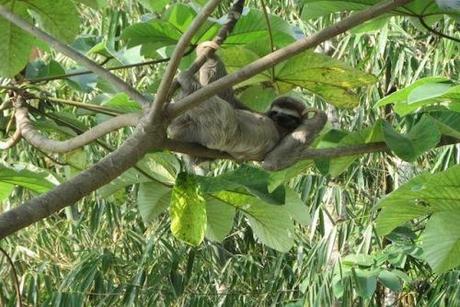
by John Stringos
This focus, by both government and citizens, on ecotourism and conservation makes nature the standout feature of anybody’s trip. As I mentioned before, being part of a pretty large and raucous wedding party, we were not in Costa Rica primarily to nature-watch. However, nature is kind of hard to miss in Costa Rica.
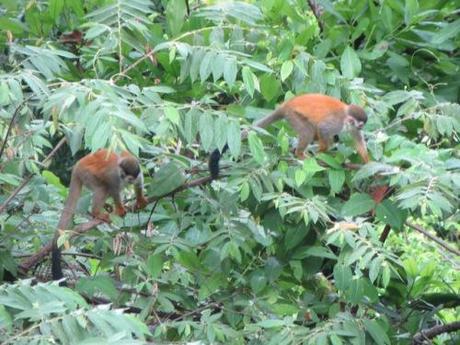
Spider Monkeys
We saw three different species of monkey from our hotel room, prompting our friends to start greeting each other by yelling “so many monkeys!” Troops of spider monkeys would appear every morning, and capuchins and howlers would pop up on the trees once or twice every day. We also saw several sloths, iguanas, caiman, and all kinds of birds- and we weren’t even trying. In Costa Rica nature comes looking for you, whether you want it or not!
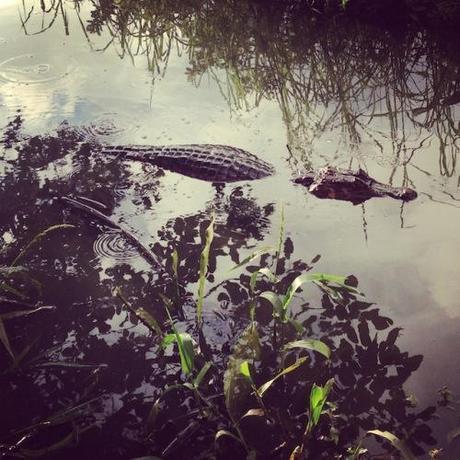
caiman by Courtney McCubbin
The beaches
The beach outside Manuel Antonio National Park is breathtaking. The dark sand seems to go on for miles in low tide. You can reach the beach from Manuel Antonio town and hotels by walking down a curvy mountain road (which can be a little scary) or taking a taxi for around $5, depending on where you start out. From the road, there is a row of stalls selling souvenirs and gifts. It seemed like everything we liked was $10.
You can rent chairs and umbrellas on the beach or just sit under the trees. Even though there are a few vendors, they are not nearly as numerous or annoying as in other parts of the world. A simple “no” is usually enough to discourage them. That being said, some vendors sell “pipas,” coconut water inside the coconut. A “pipa” is a great, inexpensive drink at the beach. For those who think ahead, a bit of rum and you’ve got yourself a Coco Loco.
We also rented a car for around $65 a day and drove to Playa Bahía Ballenas, about 70 km south of Manuel Antonio. There is a fee to enter this park (I can’t remember, but it was less than $10), but it is worth it. Even larger than the beach at Manuel Antonio, at low tide the beach comes out to form the shape of a whale’s tail, hence the name of the park. This beach was teeming with life, and very few people. The beach is very large and there are no shops or vendors inside the park, so it is important to take plenty of water. There are a few stores and restaurants right outside the park where you can load up on provisions, but remember to take your trash out of the park with you when you leave.

Playa Bahía Ballenas
We ate at one of the restaurants outside the park and had one of our best, and least expensive, meals. For about $40, three of us ate fried fish, a huge plate of fried green plantains, three different kinds of ceviche, much more food and many beers and Tequilas. It was fantastic.
The next day we had the car, we drove to playas Dominical and Dominicalito. Dominicalito is a smaller beach with a surf school. There are no other businesses on the beach and it is very quiet and beautiful. Another place to remember to plan ahead and bring provisions. Dominical, five minutes away, has all kinds of businesses and is geared towards the surfer/backpacker crowd. Dotted with hostels and beach shops, this beach was also filled with stalls selling all kinds of souvenirs. Everything here was also $10.
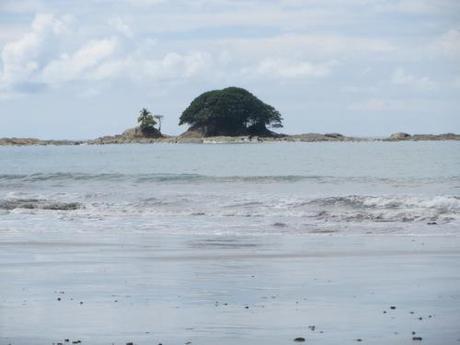
playa Dominicalito
The food
I couldn’t write about a place without talking about the food. Costa Rican food is fantastic, if not too urbane or varied. Gallo pinto for breakfast, Casado for lunch, and fresh ceviche and fried whole fish for dinner: heaven! Gallo pinto is a mixture of rice and red beans, usually served with eggs and sour cream. Casado is a platter of rice, beans, plantain, salad and either grilled fish, beef or chicken. Mahi-mahi ceviche is on almost every menu and red snapper is usually served filleted or fried whole, sometimes with a garlic butter sauce. What Costa Rican food lacked in sophistication, it made up for in freshness and taste.
Here I must pause to make a mention of “salsa Lizano.” It seems like the ticos try to keep this delicious secret sauce from the tourists; we discovered it by accident on a boat trip. In the restaurants that cater to tourists Lizano is not usually set on the table. However, no matter where you eat, there is Lizano sauce in every Costa Rican kitchen-you just have to ask for it. It’s a kind of A-1 sauce with lots of cumin and goes amazing with fish and chicken and rice and eggs and beef… I brought home two bottles- and I’m not sharing.
Our favorite restaurants in the Manuel Antonio area were Ronnie’s Place, El Típico, and the restaurant at Hotel Mariposa. Ronnie’s Place overlooks the ocean and is a great place to watch the sunset. The food is fantastic. I was on a fried whole fish kick, so I had a huge snapper that I am still dreaming about. They have a flaming banana dessert at the end that comes with a dance and show. Have a few drinks before you order this. My husband and friend ordered the lobster and it was fantastic. Ronnie, the proprietor, is often there and he makes you feel like an old friend.
El Típico is a small restaurant in the center of Manuel Antonio, specializing in local fare. I had the pork tortilla dish and it was marvelous. They had no fish, but their casado was very good. Their tres leches is one of the best I’ve ever had, even though it looked like it was garnished with parsley- whatever it was, it was delicious.
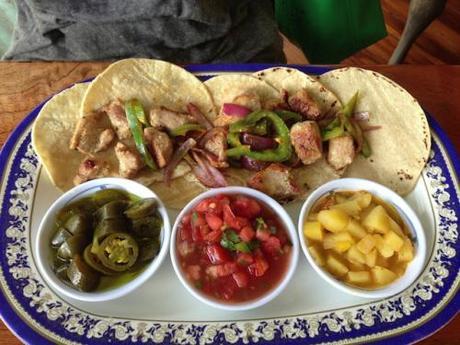
El Tipico lunch by Courtney McCubbin
Even if just for the view, a trip to Manuel Antonio commands a visit to the restaurant at Hotel Mariposa. Even though it is expensive, the food was fantastic. Again, the fried fish was superb, and this time it came with a garlic butter sauce that made that snapper sing. I thought that their rice with shrimp was a bit dry, though.
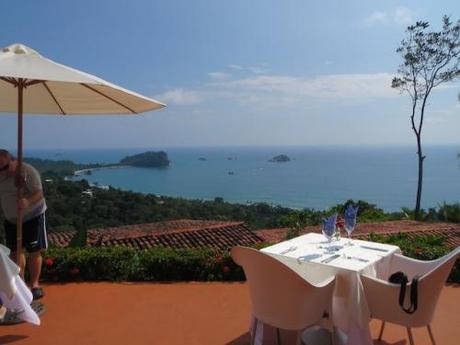
Manuel Antonio NP from Hotel Mariposa
Finally, El Avión is a must-see. This old airplane-turned-restaurant is so well done you feel like you are in Latin Disneyland for five minutes. It is really spectacular. We ordered the seafood platter with fish, shrimp, lobster, and calamari. It was good, but the fish at the other places was better.
The food at our hotel, Shana, was also superb. The wedding reception was held at the hotel and the food was phenomenal! Their daily breakfast is also tasty and varied, with fresh juice and fantastic coffee. My husband and I ate their calamari and ceviche almost every day!
Being Colombian, I expected a lot more fruit. However, the fruit that was available- mango, pineapple, papaya- was delectable. On our way to Dominical we passed a fruit vendor on the road. He had the sweetest granadillas. On our first day we bought six. On the second day we bought 30! If you have never had one, you must try a granadilla when you get the chance- but remember not to chew the seeds or you will be on the toilet for a while. Chewing a few seeds is ok, though.
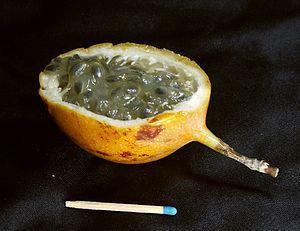
Passiflora ligularis Deutsch: Aufgeschnittene Granadilla (Photo credit: Wikipedia)
The people
By far, my favorite thing about Costa Rica and what will probably be the reason that I return was its people. From the staff at our hotel (Shana in Manuel Antonio), to the taxi drivers, wait staff, restaurant owners, store clerks, food vendors, tour guides, and even police officers, Costa Ricans are welcoming and incredibly nice. They are a happy people, proud of their country, and happy to share it with tourists.
The large expat community (the staff at our hotel consisted of several Costa Ricans, one can-do Colombian, a quiet Frenchman, and even a fantastic young man from India) shows Costa Ricans’ open-mindedness and inclusive character. It also shows that people from all walks of life and corners of the world call this little slice of heaven home. Of course not all Costa Ricans are nice; there was one crazy beach shop owner and a grumpy taxi driver, but in general, Costa Ricans are polite, helpful and extremely friendly.
So, would I go back? In a minute. It was a little more expensive than I expected and the nice spots seem to all be a long car-ride away from an airport, but all in all, I loved Costa Rica and would recommend it to anybody who loves nature, great food, and wonderful people.
Go back to Travel
